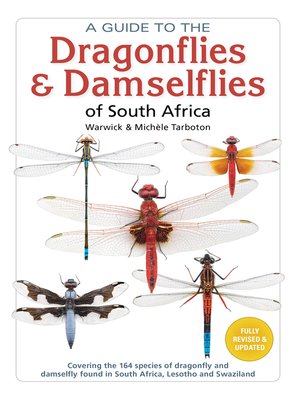
Sign up to save your library
With an OverDrive account, you can save your favorite libraries for at-a-glance information about availability. Find out more about OverDrive accounts.
Find this title in Libby, the library reading app by OverDrive.



Search for a digital library with this title
Title found at these libraries:
| Library Name | Distance |
|---|---|
| Loading... |
In this fully revised edition of A Guide to Dragonflies & Damselflies of South Africa, all 164 species known to occur in South Africa, Lesotho and Swaziland are described and illustrated, grouped according to family (six dragonfly and six damselfly families). The species entries feature scans of live insects (close-up and side-view images) and photographs of specimens in their natural environment and showing key behaviours. Detailed descriptions focus on size, identifying features and occurrence. An introductory chapter unpacks the life cycle, behaviour, biology and breeding of this fascinating group of insects. Presented in a classic field guide format, this revised edition now also features: expanded annotations to all illustrations, highlighting diagnostic features to ensure accurate identification; updated distribution maps; additional colour plates and photographs. Beautifully designed, informative and authoritative, this book will appeal to anyone with an interest in South Africa's insect life, and to nature lovers in general. Sales points: Text and distribution maps fully updated and revised; lavish colour plates make ID easy; growing area of interest; the authors' two previous books on this topic were well received and have sold through (now out of print). This fully revised edition of A Guide to Dragonflies & Damselflies of South Africa, all 164 species known to occur in South Africa, Lesotho and Swaziland are described and illustrated, grouped according to family (six dragonfly and six damselfly families). The species entries feature scans of live insects (close-up and side-view images) and photographs of specimens in their natural environment and showing key behaviours. Detailed descriptions focus on size, identifying features and occurrence. An introductory chapter unpacks the life cycle, behaviour, biology and breeding of this fascinating group of insects. Presented in a classic field guide format, this revised edition now also features: expanded annotations to all illustrations, highlighting diagnostic features to ensure accurate identification; updated distribution maps; additional colour plates and photographs. Beautifully designed, informative and authoritative, this book will appeal to anyone with an interest in South Africa's insect life, and to nature lovers in general. Sales points: Text and distribution maps fully updated and revised; lavish colour plates make ID easy; growing area of interest; the authors' two previous books on this topic were well received and have sold through (now out of print).







